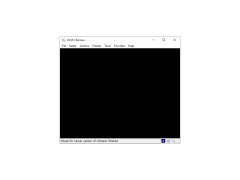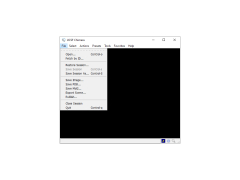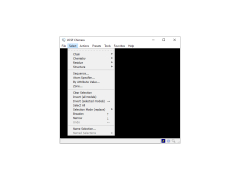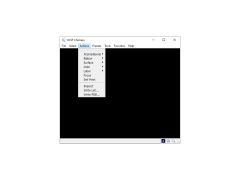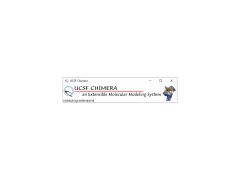
UCSF Chimera
by The Regents of the University of Calif...
UCSF Chimera is a highly extensible molecular modeling system for visualizing, manipulating, and analyzing molecular structures and related data.
Operating system: Windows
Publisher: The Regents of the University of Calif...
Antivirus check: passed
UCSF Chimera is a molecular modeling and visualization program developed by the Molecular Graphics Laboratory of the University of California, San Francisco. It is a powerful, interactive graphical program for viewing, manipulating, and analyzing molecular structures and related data. Chimera was designed for the visualization and analysis of large macromolecular assemblies, such as those found in proteins, viruses, and other large molecules.
UCSF Chimera provides an unprecedented level of interactivity and ease of use to molecular visualization and analysis. It offers a number of features that allow users to quickly and easily view, manipulate, and analyze molecular structures and related data:
• Visualization: Chimera provides interactive graphics, animation, and stereoscopic viewing of molecular structures. Users can easily manipulate and visualize molecular structures in 3D and use a variety of tools to explore and analyze them.
• Molecular Mechanics and Dynamics: Chimera offers a variety of tools for performing molecular mechanics and dynamics calculations. These tools allow users to perform energy minimization and molecular dynamics simulations on their structures, as well as to calculate and analyze electrostatic potentials and other physical properties of molecules.
• Molecular Modeling: Chimera offers a range of tools for creating, editing, and analyzing molecular structures. These tools allow users to build and refine their models, as well as to compare them to experimental data.
• Structure Comparison and Analysis: Chimera provides a variety of tools for comparing and analyzing molecular structures, such as sequence and structure alignment tools, structure superposition, and structure comparison.
• Molecular Visualization and Rendering: Chimera offers a range of tools for creating and rendering high-quality images and movies of molecular structures. These tools allow users to visualize their models in a variety of ways, including isosurfaces, cartoons, and ribbon diagrams.
• Scripting and Automation: Chimera offers a range of tools for automating complex tasks and creating custom scripts. These tools allow users to create scripts that can be used to automate tasks such as energy minimization, molecular dynamics simulations, structure comparison, and molecular visualization.
• Interactive Graphical User Interface: Chimera provides an interactive graphical user interface that makes it easy to use the various tools and features of the program. The interactive graphical user interface allows users to easily access the tools and features of the program, as well as to customize the interface to suit their needs.
• Platform Independent: Chimera is a platform independent program, meaning it can be used on any operating system. It is available for Windows, Mac OS X, and Linux.
UCSF Chimera provides a user-friendly platform for visualizing, manipulating, and analyzing molecular structures and associated data.Features:
UCSF Chimera provides an unprecedented level of interactivity and ease of use to molecular visualization and analysis. It offers a number of features that allow users to quickly and easily view, manipulate, and analyze molecular structures and related data:
• Visualization: Chimera provides interactive graphics, animation, and stereoscopic viewing of molecular structures. Users can easily manipulate and visualize molecular structures in 3D and use a variety of tools to explore and analyze them.
• Molecular Mechanics and Dynamics: Chimera offers a variety of tools for performing molecular mechanics and dynamics calculations. These tools allow users to perform energy minimization and molecular dynamics simulations on their structures, as well as to calculate and analyze electrostatic potentials and other physical properties of molecules.
• Molecular Modeling: Chimera offers a range of tools for creating, editing, and analyzing molecular structures. These tools allow users to build and refine their models, as well as to compare them to experimental data.
• Structure Comparison and Analysis: Chimera provides a variety of tools for comparing and analyzing molecular structures, such as sequence and structure alignment tools, structure superposition, and structure comparison.
• Molecular Visualization and Rendering: Chimera offers a range of tools for creating and rendering high-quality images and movies of molecular structures. These tools allow users to visualize their models in a variety of ways, including isosurfaces, cartoons, and ribbon diagrams.
• Scripting and Automation: Chimera offers a range of tools for automating complex tasks and creating custom scripts. These tools allow users to create scripts that can be used to automate tasks such as energy minimization, molecular dynamics simulations, structure comparison, and molecular visualization.
• Interactive Graphical User Interface: Chimera provides an interactive graphical user interface that makes it easy to use the various tools and features of the program. The interactive graphical user interface allows users to easily access the tools and features of the program, as well as to customize the interface to suit their needs.
• Platform Independent: Chimera is a platform independent program, meaning it can be used on any operating system. It is available for Windows, Mac OS X, and Linux.
UCSF Chimera is a powerful molecular visualization system from the University of California, San Francisco (UCSF). It is available for a variety of platforms, including Windows, Mac OS X, and Linux.
The minimum technical requirements for UCSF Chimera vary depending on the platform. For Windows, you will need Microsoft Windows 7 SP1 or later, with at least 4GB of RAM and 500MB of free hard drive space. For Mac, you need Mac OS X 10.7 or later, with at least 4GB of RAM and 500MB of free hard drive space. For Linux, you need a Linux distribution with a compatible X11 server.
In addition, UCSF Chimera requires an OpenGL 2.1-compatible graphics card with at least 128 MB of dedicated video RAM. You will also need to install a compatible Python runtime environment if you want to use the Python scripting interface.
The minimum technical requirements for UCSF Chimera vary depending on the platform. For Windows, you will need Microsoft Windows 7 SP1 or later, with at least 4GB of RAM and 500MB of free hard drive space. For Mac, you need Mac OS X 10.7 or later, with at least 4GB of RAM and 500MB of free hard drive space. For Linux, you need a Linux distribution with a compatible X11 server.
In addition, UCSF Chimera requires an OpenGL 2.1-compatible graphics card with at least 128 MB of dedicated video RAM. You will also need to install a compatible Python runtime environment if you want to use the Python scripting interface.
PROS
Provides detailed molecular structures and visualization tools.
Offers extensive documentation and tutorials.
Supports a wide range of file formats.
Offers extensive documentation and tutorials.
Supports a wide range of file formats.
CONS
May be challenging for new users to understand complex features.
Lacks comprehensive beginner-friendly tutorials and guides.
Occasionally slow when handling large datasets.
Lacks comprehensive beginner-friendly tutorials and guides.
Occasionally slow when handling large datasets.
Brodie Shaikh
UCSF Chimera is a powerful and versatile molecular graphics software. It is great for visualizing and analyzing structures of biological macromolecules. Its user interface is intuitive and easy to learn. I found the 3D visualization feature to be particularly helpful in exploring the structural features of proteins. It is also easy to customize the display and options to suit individual needs. The molecular surface rendering option is also very useful for understanding complex surfaces. I found the tools to be quite helpful in understanding the structure and properties of molecules. Overall, I am very impressed with the features and capabilities of this software.
Owen Berlant
I found UCSF Chimera to be a great tool for visualizing proteins, but it was a bit challenging to navigate at first and defintiely requires some learning curve.
Robbie Guenthner
Using UCSF Chimera software has been an overall positve experience, although the setup can be a bit tricky to navigate at times.
Kai Thomma
UCSF Chimera is a software that allows users to visualize and analyze molecular structures and related data. Key features of the software include the ability to display and manipulate structures in 3D, create publication-quality images and animations, and perform molecular modeling and simulation. Additionally, UCSF Chimera supports a wide range of file formats and includes tools for analyzing and comparing multiple structures.
Alfie D*********v
UCSF Chimera software is a powerful tool for visualizing, analyzing, and manipulating molecular structures and related data.
Liam
An excellent visualization tool with diverse features, yet requires a steep learning curve for beginners.
Ethan
Advanced, robust tool for molecular visualization and analysis.
Blair
Reliable for molecular modeling.
